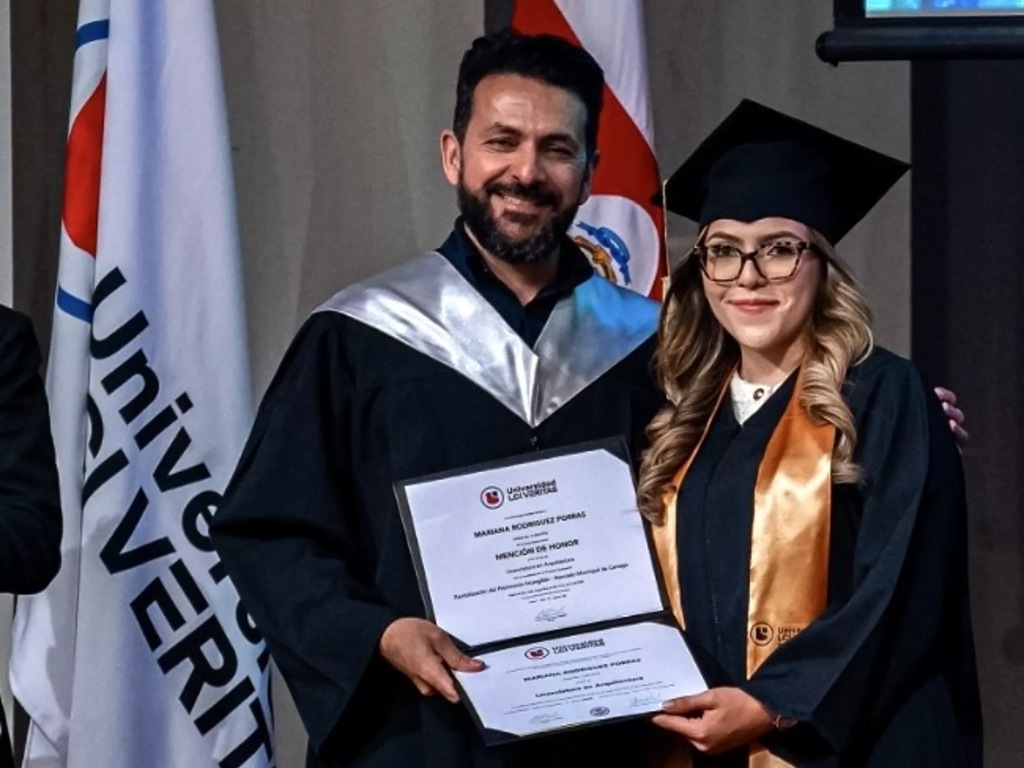LCI VERITAS Valedictorian Mariana Rodriguez talks about Sustainability and Authenticity as an Emerging Architect

Mariana, Congratulations on completing your bachelor's degree and for being selected as Valedictorian!
Thank you!
Tell us what’s next on your path... what are you working on now?
I was hired by an architectural firm. I am currently involved in the design process and the preparation of construction plans, where I participate in weekly inspections and construction reviews.
I am gradually progressing through the different stages of construction, , and seeing tangible results, and gaining deeper knowledge and understanding of construction.
How does it feel now that you have graduated to live some of the daily reality of Architecture?
It is gratifying to be able to combine the theory and technical skills learned at LCI VERITAS with the practice on the construction site, where I can see how ideas become reality.
What’s a typical day at work like for you right now?
My days at work are varied and dynamic, which I love because I am always learning new things and facing new challenges. Versatility is key in my day-to-day, as I need to be able to move between different projects and solve problems in each of them.
Seeing how things work on the job site and how problems are solved in real time gives me a broader perspective, so I can approach future projects with greater awareness.
As a recent graduate and emerging professional, you and your peers are the future of architecture.
Thank you! I appreciate the confidence you have in emerging professionals like myself. As a recent graduate, I'm excited to bring fresh perspectives and innovative ideas to the field.
What are some challenges emerging architects may face?
Because there are so many directions an architect’s career may take, we need to adapt with intention
The world of work outside of college is very competitive. While university provides us with a solid education, it’s up to us to keep our skills up to date. For example, we will have to learn and re-learn the programs we use to create our projects, the tools and strategies we use to communicate our ideas, how to approach clients, and the specific design skills we develop that differentiate us from other architects or other professions, not to mention key aspects of other professions we regularly engage with, such as construction, interior design, or civic law.
It is important to stay true to an individual essence and follow personal values; from there we can respond to the projects we face with greater honesty and authenticity.
Based on your own expertise, what are your hopes for the field of architecture in Costa Rica?
For the field of architecture, we need to highlight and preserve the historical heritage value that exists in many of our cities. One of my hopes is to see a greater effort to recover and restore buildings and spaces that have a rich history. It is important not only to preserve these structures, but also to give them a new purpose and use that integrates them into the life of the city. The restoration of these buildings can become an opportunity to honor the country's heritage and allow these spaces to continue to coexist with the reality of the city as time passes.
Currently the country is seeing a remarkable development of foreign investment in the coastal areas and a continuous growth of real estate investment in the Greater Metropolitan Area (GAM). Another of my hopes is to see more emphasis on sustainable architecture. Costa Rica is a world leader in environmental protection and renewable energy. All fields, including architecture, can continue to move in this direction by incorporating more energy efficient practices into their processes. The goal would be to create buildings that harmonize with the natural environment, which reduces the carbon footprint because newer developments are in locations where they coexist with a natural context.
It sounds like you take a community approach to architectural projects, which might seem idealistic to some. How can a project realistically benefit the community outside its direct scope?
I hope that architecture in Costa Rica will always consider the social and economic implications of each project and how they directly affect its context.
I hope that the importance of creating inclusive cities, by promoting urbanism that ensures access to quality public spaces for the entire population, is appreciated.
An example might be development zones within the city. When there is a high development project that reflects a large investment in one place, it is valuable to designate part of the investment to the benefit of nearby common areas, or surrounding green spaces, that are shared by all citizens.
What’s something that architects are highly skilled at that the general public might overlook?
I think the ability to tackle various problems and anticipate their implications during the design and construction process is a significant merit of architecture, and one that could go unnoticed by people in general because they only see the final product.
With so many direct and indirect impacts on a project to consider, it would be easy to feel like you’re drowning in priorities. What did you learn in your degree about prioritizing that you think is helpful in everyday life?
I learned there is a difference between tasks that are important and tasks that are urgent. Important tasks relate to our long-term goals, and usually require daily discipline and consistency. Urgent tasks are those pending or unforeseen tasks or issues that pop up from one day to the next. Often, the urgent consumes our time and energy, leaving little room for the important.
It is important to find a balance: Regularly set aside time for important activities that bring you closer to your goals and allow space to deal with the urgent from day-to-day. Actually, I prioritize the same way in my work life and in my personal life. It helps me maintain a work-life balance.
How does an architect negotiate the very different priorities of each stakeholder, while also applying their own expertise and realizing their own vision?
Negotiation in architecture is about finding a balance between the client's priorities and our own professional vision. The key is understanding the client's needs, and then working towards consensus; effectively communicating our ideas and convincing the client of their validity, while being flexible and ready to adapt to client and project needs.
To target everyone’s needs while staying true to the original vision, it helps to constantly asking yourself questions like:
What is my design problem (respond to the need)?
Who am I designing for (who is my client, what is my context)?
What is my interest or challenge that I want to address and learn (what can I learn and take away from this experience for my professional career)?
I believe that informed and honest reflection always leads to an authentic answer.
It can feel increasingly difficult to stay authentic these days. Can you tell us what authenticity means to you?
To me, authenticity means being true to personal ideas and values. Each of us has a story, a context, a unique reality, beliefs, and values. These things define who we are, characterize us, and differentiate us from others. Allowing this uniqueness to guide us makes us authentic.
So, what do you intend to do to stay authentic in your career?
I intend to approach the projects in my career by following my personal design approach that aligns with my beliefs and values and keeps me true to my ideas.
Inspiration is subject to interpretation. We all experience the world from the perspective of our own reality, and that influences how we respond to everything in life. Our personal experiences enrich our design decisions and processes.
I think it’s the architects who stay true to their principles and design strategy that leave a distinctive mark. Over time, this fidelity to their ideas becomes what distinguishes their work.
Mariana, thanks for talking to us today! Good luck with this next stage in your career, and keep us updated!
I will! Thank you!




